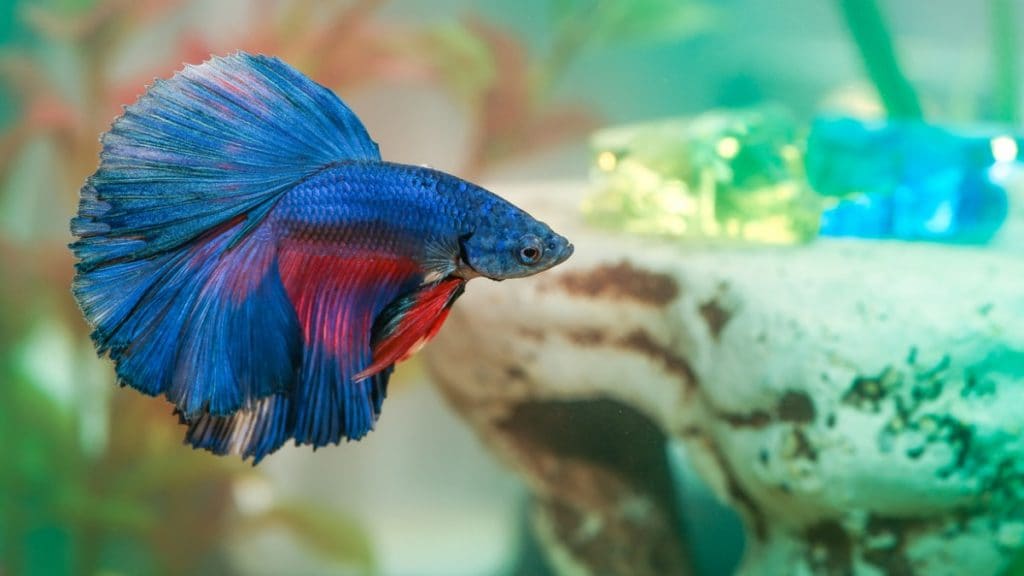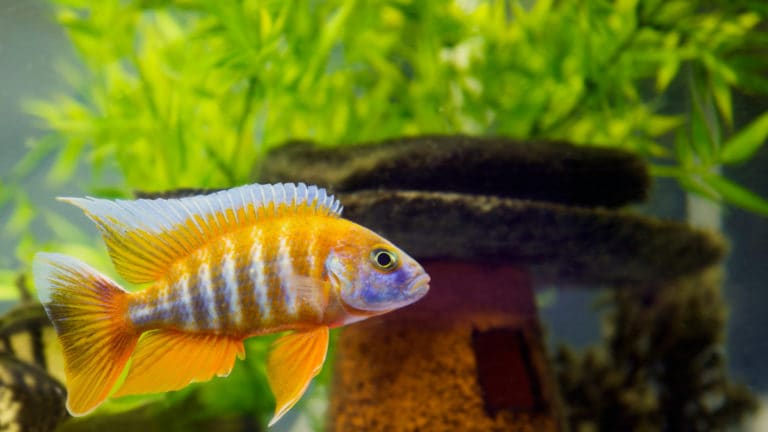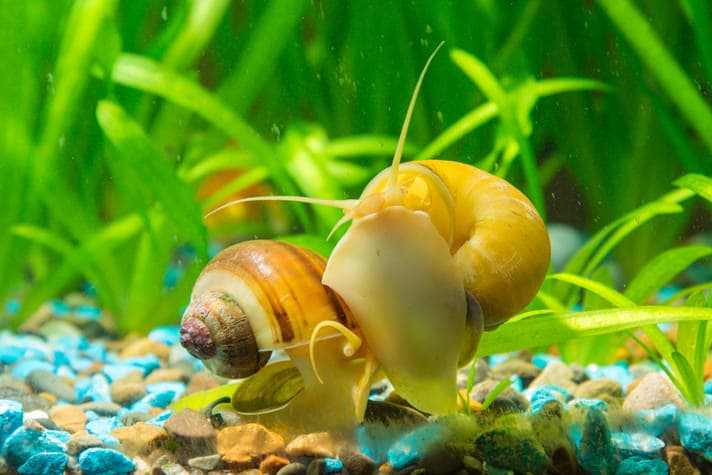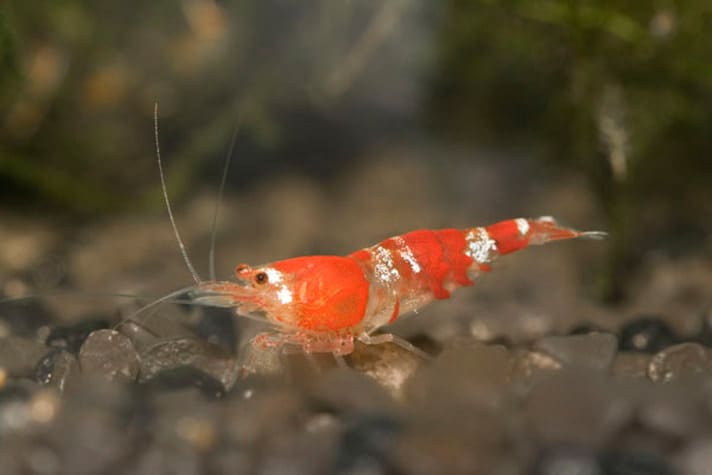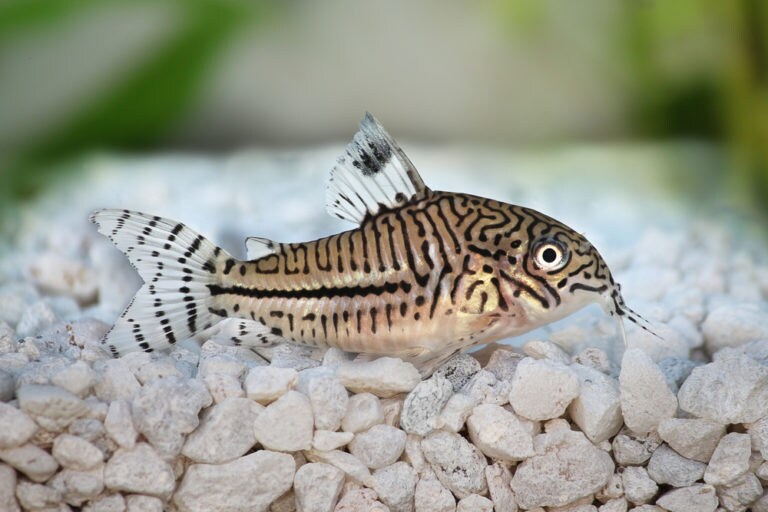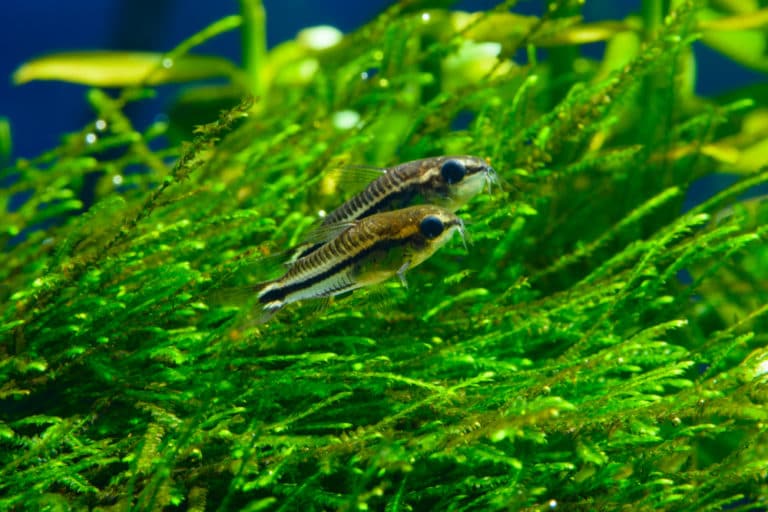In This Guide:
Betta Fish Overview
While there are over 70 members of the genus Betta, the most popular species in the aquarium hobby—and the one often referred to simply as the betta—is Betta splendens.
Betta fish are endemic to Thailand, formerly Siam, which is why this species was once known as the Siamese fighting fish. The nickname also reflects the species’ natural territorial and aggressive attitude toward male betta fish.
Wild Betta splendens are unremarkable in appearance but may exhibit strong coloration when agitated. Ornamental betta fish, on the other hand, have been selectively bred for brilliant colors and a variety of fin shapes. They’re some of the most vibrant freshwater fish in the aquarium trade.
- How big can betta fish get? Betta fish generally only grow to a length between 2.5 and 3 inches, though long-finned varieties may appear to be bigger.
- How long do betta fish live? Both wild and captive-bred betta fish live for an average of 5–7 years.
What Do Betta Fish Need?
Before you bring home your new betta, you’ll need to establish an appropriate environment. Here’s a list of betta fish supplies needed for a healthy tank setup:
- Aquarium (5 gallons or more)
- Lid on your tank (necessary to prevent your betta from jumping out)
- Filter
- Heater and thermometer
- Decorations to provide your betta with comfortable places to hide and feel secure
- Water (spring water is best, but tap water is fine if you use dechlorination drops)
- Water conditioner
- Water quality test strips
- Betta fish food
- LED light (necessary to keep live plants in your aquarium and to help your betta with their natural day and night pattern)
- Aquarium plants (live plants are best, artificial plants are fine)
- Substrate like sand, gravel, rocks, etc.(optional)
- Bucket with lid (optional, to hold conditioned water for water changes)
Once you’ve stocked up on basic betta fish supplies, take them home and get the tank set up before purchasing your fish. Use the test strips to determine the quality of the water before you add your fish. It may take several weeks for the tank to cycle and become safe for your new betta. (More on fish tank cycling below.)
Aquarium Setup for Betta Fish
Setting up and maintaining a suitable tank environment is the key to keeping your new fish happy and healthy. Factors like poor water quality, unsuitable pH level, and inadequate tank size can all have a negative impact on the lifespan of your betta fish. Here’s what you need to know about setting up an ideal betta habitat.
Betta Fish Tank Size
While betta fish only get to be about 3 inches long in body, their long fins may take up additional space. So, how many gallons of water does a betta fish need?
At minimum, betta fish need 10 gallons of water. Larger tanks are preferable, because they provide more space for your fish to roam. They’re also easier to maintain since higher volumes of water are less likely to be impacted by fluctuations in water chemistry or temperature.
Betta Fish Tank Decor
In the wild, bettas inhabit still and slow-moving bodies of water like rice paddies. Their native environment is lush with vegetation that provides plenty of hiding places. You can replicate the characteristics of these environments by providing your betta with decorations like plants (real or fake), logs, and caves.
But you can’t put just anything in your betta’s tank. Here’s what to avoid:
- Sharp decorations that can snag or tear your fish’s fins
- Metal items that will rust
- Painted ornaments (the coating will degrade and flake off in the water)
- Seashells, dried coral, or beach sand, which can alter the pH of your tank water
Be sure not to overcrowd the tank with decorations, and leave some open space at the top of the tank. Betta fish have a labyrinth organ that enables them to breathe air from the surface, so don’t cover the top of the tank with floating decorations. Surface space will also be needed if your betta decides to build a bubble nest.
However, make sure your tank has a cover, as betta fish are known to jump.
The 5-gallon Marineland® Portrait™ Blade Light Aquarium Kit is a great option for betta fish parents because it comes complete with filtration and lighting right out of the box. If you live in a place with nice natural light, your betta may not require an artificial light source, but if the room your fish lives in is darker, you’ll want to give it an aquarium light too.
Equipment
The most important pieces of equipment for a betta tank are the heater and filter.
Betta Fish Tank Heaters
The ideal betta fish water temperature is between 76–81 degrees Fahrenheit, ideally at the upper range of those temperatures, to be comfortable. Betta fish need a heater to keep the temperature in range, and you should choose one with enough power to heat your whole tank. The general rule is 1 watt of power per 1 liter (3.8L per gallon) of water; for a 5-gallon tank, for instance, you’ll need at least a 20-watt heater.
You’ll also need a thermometer to make sure your tank water is at the ideal temperature.
Betta Fish Tank Filters
Betta fish need a filter to maintain healthy and stable water parameters. In addition to circulating tank water to improve oxygenation, aquarium filters utilize different types of filter media to help remove substances from the water that might harm your fish.
Mechanical filter media like sponges remove large particles like uneaten fish food and waste, while chemical filter media removes dissolved toxins. Biological filter media supports the proliferation of the beneficial bacteria that maintain the nitrogen cycle in the tank.
When choosing a filter for betta fish, consider the tank size and output rate. Check the packaging of the filter to ensure it's rated for your aquarium’s size. Choose a filter with a low or adjustable output rate, so you can modify the flow to best suit your fish. Excessive flow can stress your betta and may cause long-finned varieties to tire themselves quickly fighting against the current.
Betta Fish Tank Lighting
Lighting can enhance the aesthetics of your tank and improve the viewing of your fish. Adequate lighting is required if you plan to stock your betta tank with live aquarium plants.
Cycling Your Water
You’ve chosen a tank, added the conditioned tap water, installed the filter, placed the heater and arranged your decor. But wait—don’t put your betta in that water just yet! First, it’s important to turn everything on and let your aquarium system run for four to six weeks without a fish in it.
This waiting period is called cycling, and it’s one of the toughest parts of the process—you’ll be anxious to put your betta into this great new tank! But it’s well worth the wait to ensure the health of your fish. During this time, you’ll want to test your water daily to ensure its quality is improving.
Cycling allows time for crucial bacteria to start inhabiting all the surfaces of your aquarium. This is important because these bacteria are required to break down ammonia, the primary waste product of fish excreted through their gills, into nitrite and nitrate. If ammonia and nitrite build up in your tank and are not removed through breakdown by bacteria and/or water changes, they will kill your fish. The best way to avoid this unfortunate outcome is to let your tank cycle before adding a fish.
If you can’t wait to put your betta in the tank, or you just want to jumpstart the cycling process, add API® Quick Start™ to your aquarium. This is a liquid filled with bacteria that will immediately begin to establish the biological filtration your aquarium needs.
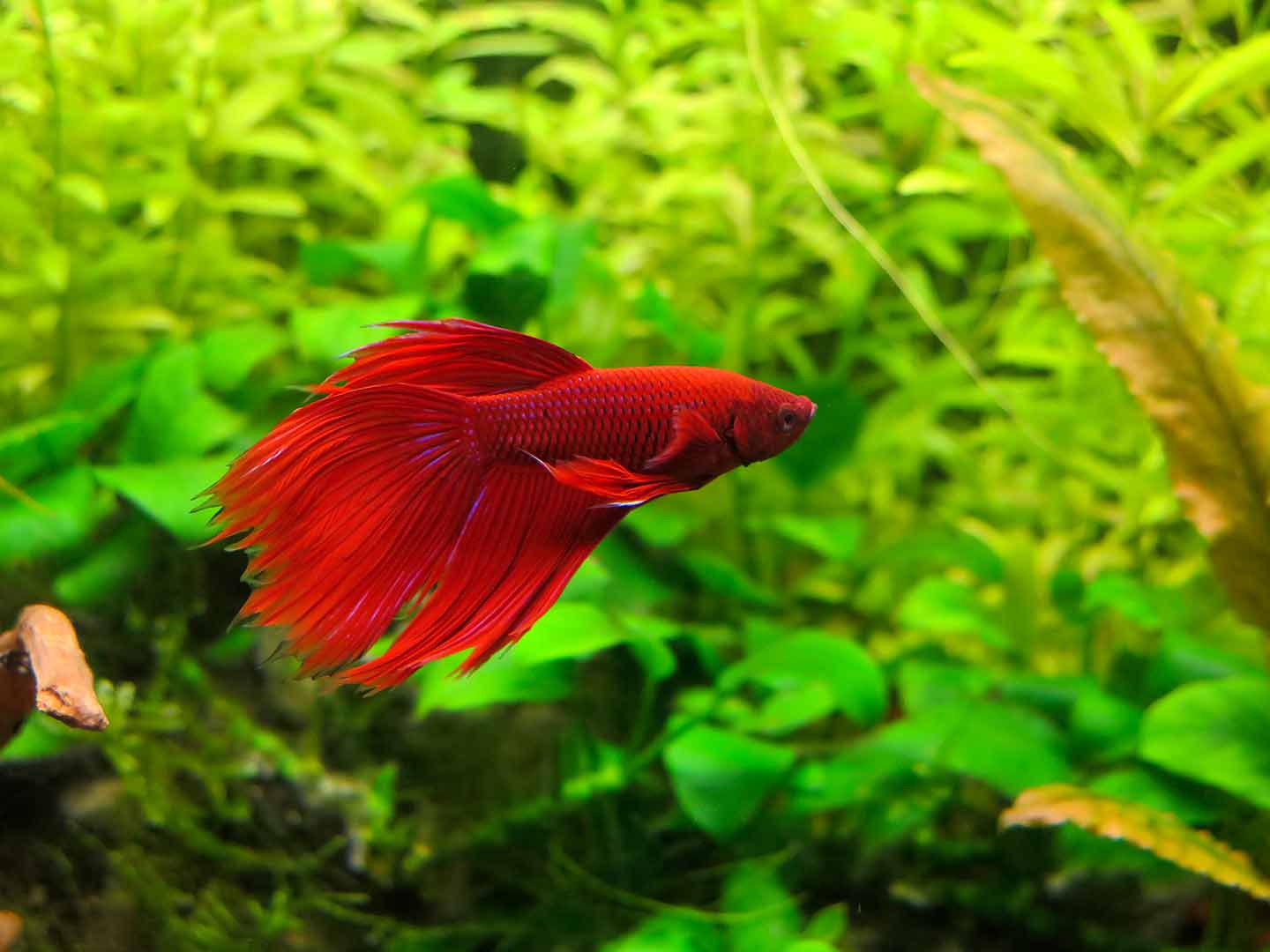
iStock.com/Laraish
Betta Fish Tank Maintenance
Bettas have specific requirements for tank temperature, pH level and other measures of water quality. Here’s how to maintain your tank to ensure a healthy betta.
Water Quality
Test your betta’s tank water weekly to make sure it has healthy levels of compounds, ions, and pH. You can do so easily using an aquarium water test kit or by using test strips like API®’s 5-in-1 Test Strips. The most important parameters to test are ammonia, nitrite, and nitrate. As organic waste in your betta’s tank breaks down, it produces ammonia that beneficial bacteria convert into nitrite and then nitrate.
Nitrate is the less dangerous of the two, but still should be kept within a safe range between 0 and 40 ppm. If you get a high nitrate reading, change 50 percent of the water. Nitrite, while less toxic than ammonia, is still quite harmful to your fish. If you get a reading of any nitrite at all, you’ll want to do a large water change immediately.
Most aquarium test kits also test for pH. Bettas do best when kept in water with a neutral pH of around 7, though they can tolerate a range of 6.5–7.5. Tap water in most places falls somewhere between 6.5–8.5, so it’s a good idea to check the pH of your tap water before putting your fish in it, as too high or low a pH level will seriously stress out your betta.
Regular water changes help keep the parameters in your betta tank stable. When performing a water change, be sure to treat the new water with a water conditioner like API® Tap Water Conditioner™ to remove chlorine and detoxify heavy metals. It’s a great idea to have a bucket filled with conditioned tap water ready for when you need to do water changes.
Cleaning Your Aquarium Filter
Filter maintenance looks different depending on the type of filter you’re using. Many filtration systems come with three types of filter media designed to be used simultaneously in one filter cartridge. With these systems, you generally only need to change the cartridge once a month.
Other filtration systems (like canister filters) may utilize loose filter media or individual packets. Here are some of the most common options:
- Mechanical filter media is usually a sponge or pad that physically strains waste particles from the water. It should be cleaned monthly by squeezing it into a bucket of conditioned water.
- Chemical filter media is typically activated carbon that works by adsorption, a chemical reaction that traps pollutants inside the carbon. It should be replaced monthly.
- Biological filter media (bio-media) is generally a substrate, such as ceramic, with a large surface area to house and grow beneficial bacteria. This generally does not need to be replaced, as long as it stays wet, but it does need to be in an area with good water flow and rinsed regularly to remove debris.
Perhaps the best option for betta fish is a sponge filter. A sponge filter is simply a high-quality foam sponge that fits onto a central strainer. Sponge filters provide plenty of space for beneficial bacteria to grow, and they offer lots of control over the flow rate. They don’t provide chemical filtration, but it may not be necessary unless you’re trying to remove medication or other chemical treatments from the tank water.
Care Schedule
Bettas are fairly low-maintenance pet fish, but establishing a routine for basic cleaning and maintenance tasks is essential for optimal health. Here’s a quick overview of recommended daily, weekly, and monthly tasks:
- Daily: Feed your betta (once or twice per day); check equipment to make sure it’s working properly; check the water temperature to make sure it’s in range.
- Weekly: Test water quality with test strips or a test kit; siphon aquarium substrate to remove accumulated waste; change 15–25% of the water volume.
- Monthly: Replace filter media as needed; clean algae from the aquarium glass and decorations; change 25–50% of the water volume.
Use caution when cleaning aquarium equipment and decorations. Never use soap or household cleaning products, as these can be toxic to fish. If more than a rinse is required, gently scrub with a soft toothbrush that’s new, unused, and clean. Aquarium cleaning tools like an algae cleaning magnet or sponge algae scraper may be useful as well.
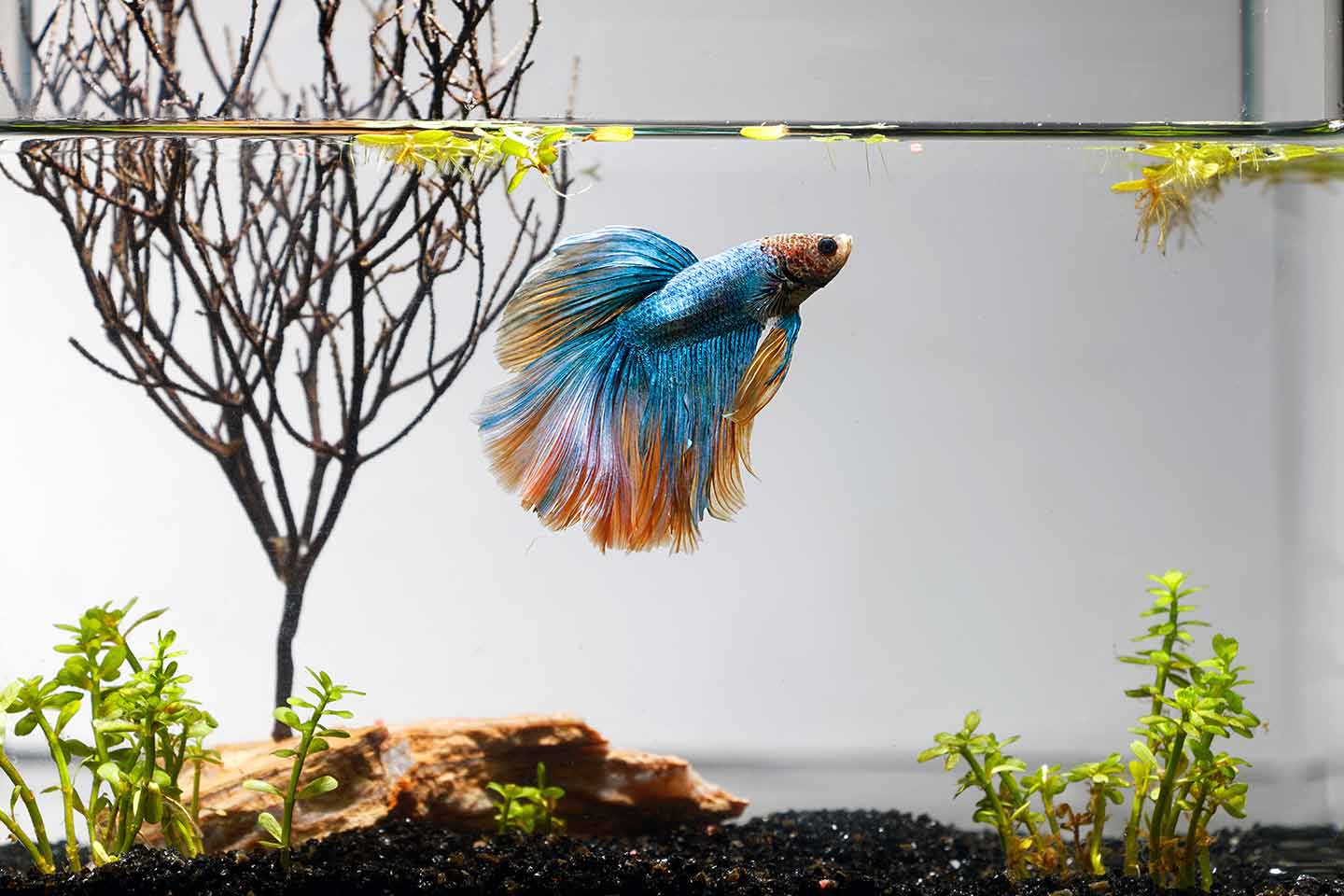
iStock.com/CmErsoy
What Do Betta Fish Eat?
Proper nutrition is a must if you want your betta to live a long and healthy life. The best food for betta fish is a staple diet of commercial betta pellets supplemented with live, frozen, and freeze-dried foods. The key is to meet your betta’s needs without overfeeding.
Betta fish are carnivorous, so it’s important to choose a product formulated specifically for betta fish. Pellets are idea—they’re small, easy to eat, and contain concentrated nutrition. Look for pellets that contain dried, meaty foods like shrimp or salmon, and replace them every six months because nutrients like vitamin C can be lost over time.
Live, frozen, and freeze-dried foods can boost your betta’s nutrition and help them achieve their most vibrant coloration. Some of the best options for bettas include bloodworms, brine shrimp, and daphnia. Always thaw frozen foods in a cup of tank water before offering them to your betta. Freeze-dried foods should be soaked before feeding as well.
If you choose to offer live foods, raise them yourself or purchase from a reputable pet store, because those of unknown origin come with a risk of carrying pathogens like parasites.
How Much To Feed Betta Fish
It’s easy to overfeed betta fish because they can be beggars, and they’ll keep eating if you keep feeding. But the risks of overfeeding are real: bloating, swim bladder disorder, difficulty swimming, and—potentially—a shortened lifespan.
When wondering how much to feed your fish, remember that a betta’s stomach is about the same size as their eyeball, so you shouldn’t feed them more than that amount at a time—no matter how cute they look when they beg for more snacks. You can tell when your betta is overfed, because their bellies will look bloated or distended. This can generally be remedied by letting them fast for a couple days.
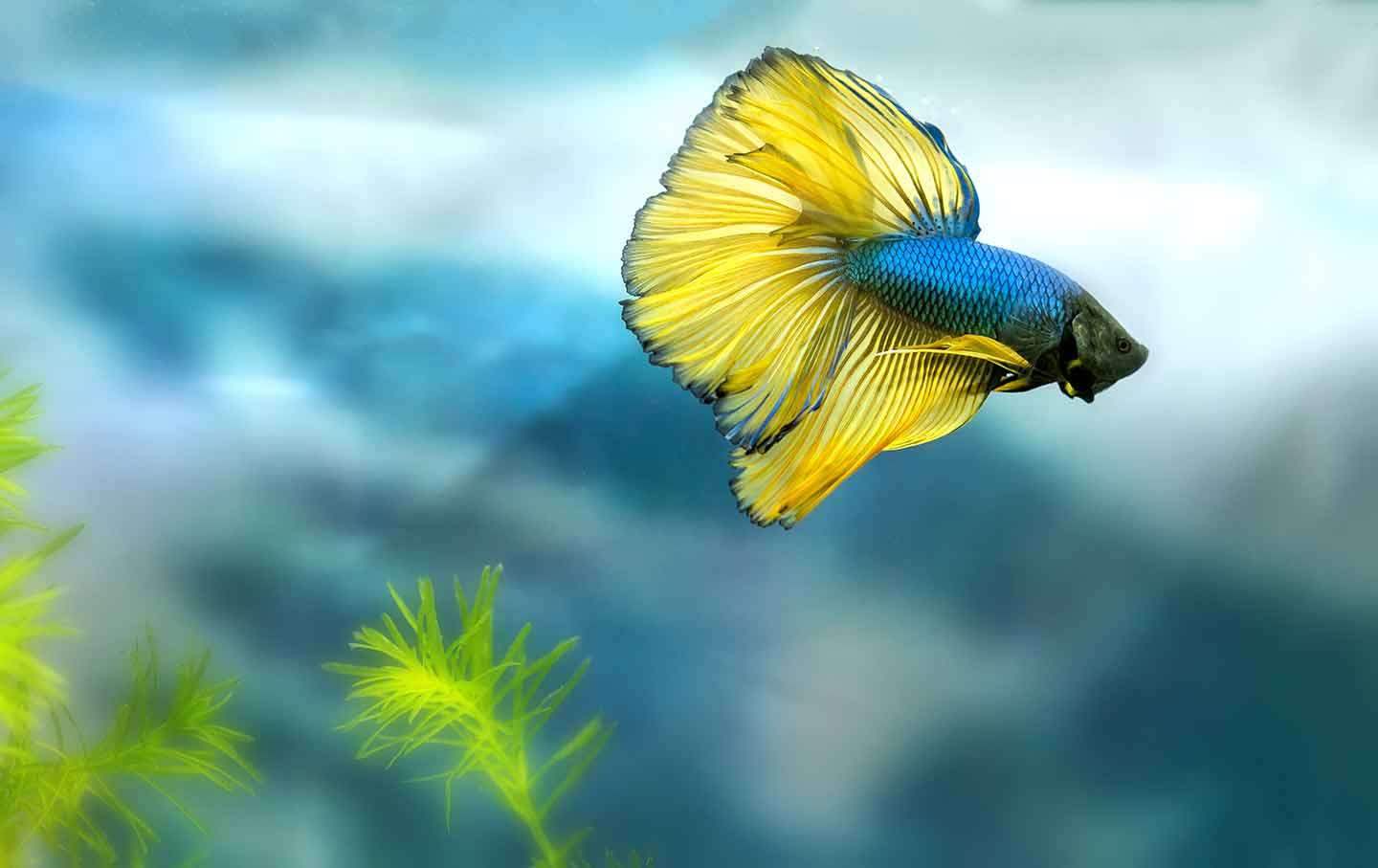
iStock.com/HuyThoai
Betta Fish Health
You can’t ask your fish how they’re feeling, so you need to know the visual signs of a healthy betta versus an unhealthy betta. Signs of good health in betta fish include bright and vibrant coloration, full and flowing fins, good appetite, and normal activity. The following are signs your betta might be unwell:
- Dull or muted colors
- Torn or ragged fins
- Clamped fins (held close to the body)
- White spots or cottony growths
- Swollen or cloudy eyes
- Poor appetite
- Lethargy or inactivity
- Hiding more than usual
In many cases, having a healthy betta versus an unhealthy one comes down to water quality. A dirty tank not only exposes your fish to pathogens or harmful conditions, but it causes stress—which may increase your betta’s susceptibility to illness. If your betta is showing signs of illness, test your water quality, perform a 50% water change, and then check all your parameters again. Water changes can fix a surprising number of problems. Also, check to make sure your water temperature is in the correct range.
Common Diseases in Betta Fish
Fin Rot
Fin rot is caused by bacteria eating away at your betta’s fins or scales, typically the result of dirty water with too much ammonia.
Fins with frayed or ragged edges; small holes; a thin or transparent appearance; red, black or white edges; inflammation or slimy texture at the base.
Start by changing 50% of the water once per day for two to three days. If the rot doesn’t begin to improve after that, dissolve 1 teaspoon per gallon of freshwater aquarium salt in fresh, dechlorinated water, then add it to your tank. Continue with the daily 75% water changes, adding the required amount of salt each time it is changed. If the rot persists, consult a veterinarian.
Velvet
Velvet is caused by parasites and is very contagious.
The appearance of yellow-ish dust covering the betta; lethargy; loss of color; loss of appetite; clamped fins (held close to the body).
Consult with a fish veterinarian to find out the best way to treat your fish. Possible treatments include Malachite Green or Coppersafe®.
Ich
Also known as “Ick” or “White Spot,” this is an infection caused by parasites.
A white, dusty appearance on your fish, resembling salt; loss of appetite, flashing (a betta behavior that involves quickly rubbing against objects), lethargy.
For early cases, treat with aquarium salt. For more advanced infections, consult a veterinarian.
Fungus
Fungal infections usually occur as the result of a pre-existing infection or injury but can also come from other infected fish or dirty water.
A blotchy, white, cotton-like slime on the fish.
Add 1 teaspoon per gallon of freshwater aquarium salt to the water. Change 50% of the water daily, adding the required amount of salt each time it is changed. Continue this for one week. If symptoms persist, consult a veterinarian.
Swim Bladder Disorder (SBD)
SBD is a common term for a variety of betta illnesses, so its causes can vary from overfeeding to bacterial infection to, in rare cases, tuberculosis. There is no clear way to determine the cause.
Difficulty swimming; lethargy.
Treatment is tricky because SBD can have many different causes. Try these steps: Avoid feeding your fish for one to two days and change at least 30% of the water. In most cases, SBD will resolve with time if the above steps are taken.
An important note about aquarium salt: Aquarium salt is specifically and carefully formulated for use in freshwater aquariums. Any other salts may have the potential to seriously harm your fish. If implemented incorrectly, salt treatment can be more damaging than helpful.
Salt can kill many aquarium plants and can be harmful to some species of fish, so if your betta is living in a community tank, it's a good idea to remove your betta and treat them in a separate aquarium called a hospital tank. A hospital tank is a small, bare aquarium with nothing in it but conditioned water, a sponge filter, heater, and thermometer. This allows treatment of just the betta instead of the whole tank, which can be beneficial depending on the disease as well as the sensitivity of other tank mates.
Betta Fish Tank Mates
Betta fish can have tank mates under the right circumstances. Because they tend to be territorial and aggressive, male bettas are best kept alone or in larger tanks with suitable companions. Female bettas can be kept in groups (called a sorority) as long as the tank is at least 20 gallons in volume.
If you’re wondering what fish can live with a betta, keep two things in mind. First, male bettas will be aggressive toward other bettas and similar-looking fish (like fancy guppies). Second, betta fish may prey on fish and invertebrates small enough to fit in their mouths. No matter what fish you keep with your betta, make sure the tank is big enough and decorate it to provide plenty of hiding places.
Potential tank mates for bettas include:
FAQs About Betta Fish Care
Q:Can betta fish see in the dark?
A:Bettas do not see particularly well in the dark. Even in the light, their ability to judge depth and distance isn’t that good, but they are great at perceiving color. They also have monocular vision, which means that each eye can see a different thing.
Q:Can betta fish eat tropical flakes?
A:Yes, bettas can eat tropical flakes as long as they are formulated for bettas. Tropical fish flakes do not have enough protein to sustain betta fish.
Q:Can betta fish live in tap water?
A:Bettas can live in tap water, but it must be treated first. Tap water contains chlorine and chloramines, as well as heavy metals such as copper, lead, and zinc, all of which can be detrimental to the health of tropical fish. You will need to use a water conditioner to remove chlorine and chloramine, and detoxify these heavy metals, making the water safe and healthy for your betta.
Q:Do betta fish need heaters?
A:Unless your room is 80 degrees Fahrenheit all year long, your betta will need a heater. These are tropical fish from Southeast Asia who are used to warm temperatures, and they thrive in water between 75 and 80 degrees Fahrenheit.
Q:Are betta fish easy to care for?
A:Bettas are generally considered to be beginner-friendly because they can be kept alone in fairly small (5 gallons at least) tanks. They’re relatively easy to care for but, like any pet fish, they require a properly equipped and fully cycled tank, along with a routine maintenance schedule to ensure high water quality.
Q:How do you know if your betta is happy?
A:A happy betta fish is a healthy betta fish. When your betta is healthy and happy, they’ll exhibit strong coloration, intact fins, and smooth, uniform scales. They will also be eager to eat and can be seen swimming around their tank instead of lolling at the bottom of the tank or hiding all day.
Get more fish care advice:
Share:
